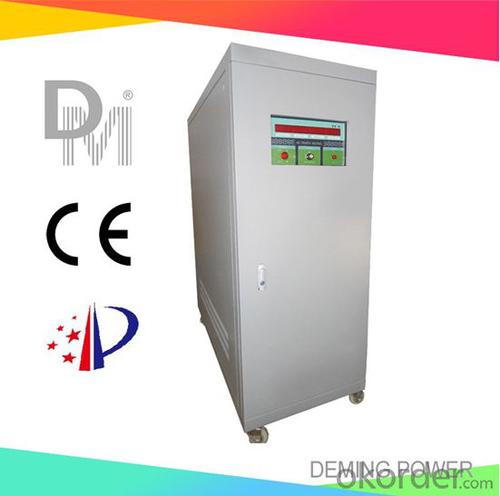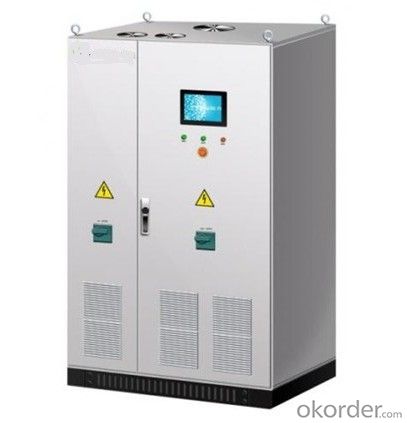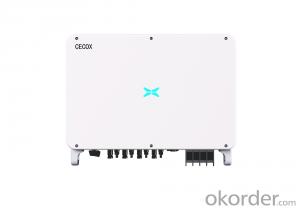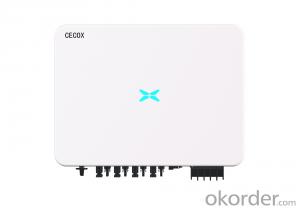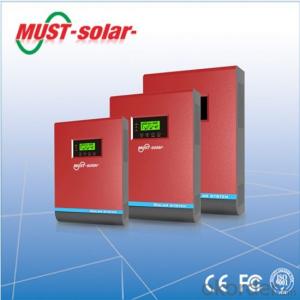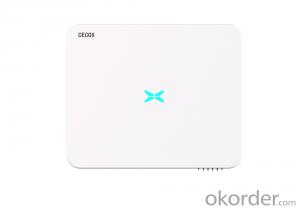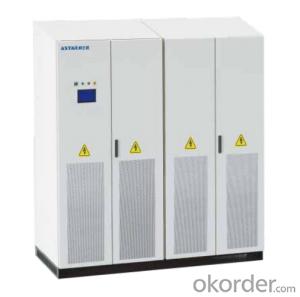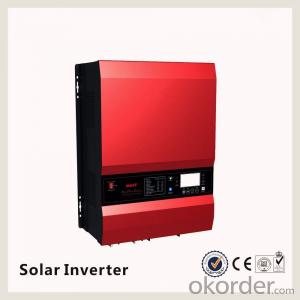Solar Inverter 12v 50kw Off Grid Three Phase Photovoltaic Inverter
- Loading Port:
- China main port
- Payment Terms:
- TT or LC
- Min Order Qty:
- 50000 watt
- Supply Capability:
- 3000000 watt/month
OKorder Service Pledge
OKorder Financial Service
You Might Also Like
1. Structure of Photovoltaic Inverter 50KW Off Grid Three Phase
A solar inverter, or PV inverter, or Solar converter, converts the variable direct current (DC) output of a photovoltaic (PV) solar panel into a
utility frequency alternating current (AC) that can be fed into a commercial electrical grid or used by a local, off-grid electrical network. It is
a critical BOS–component in a photovoltaic system, allowing the use of ordinary AC-powered equipment. Solar inverters have special
functions adapted for use with photovoltaic arrays, including maximum power point tracking and anti-islanding protection.
2. Main Features of Photovoltaic Inverter 50KW Off Grid Three Phase
• using IGBT from Mitsubishi company as the power components
•using American ATEMEL company microprocessor as figure controller
• perfect protection and warning functions
• circuit frame compact,Max. Efficiency≥94%
• with wide input voltage range
• RS232/485 communication,multi communication interface can be selected
•big-screen English LCD, perfect display, interface-friendly
3. Photovoltaic Inverter 50KW Off Grid Three Phase Images
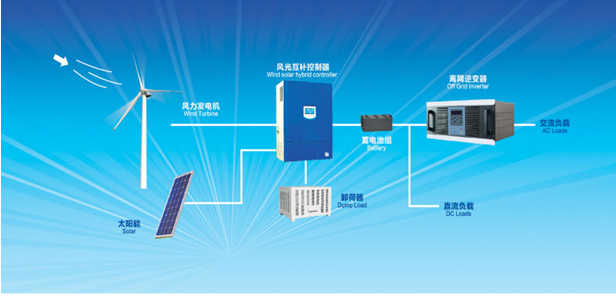
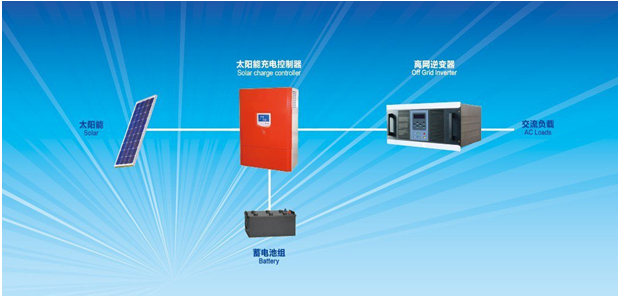
4. Photovoltaic Inverter 50KW Off Grid Three Phase Specification
窗体顶端 50KVA off grid three phase inverter technical parameters 窗体底端 | |||
Type | ND220-50KS | ND380-50KS | |
DC input | Input rated voltage | 220 VDC | 380 VDC |
Input rated current | 227 A | 132 A | |
Input DC voltage range | 180-300 VDC | 300-490VDC | |
| Allow input voltage range | 220 VAC / 380 VAC / 400 VAC ± 15% VAC | |
AC input | Input rated current | 139A / 76A / 72.5A | |
| Bypass transfer time | ≤4 ms | |
AC output | Rated capacity | 50KVA | |
Output rated power | 40KW | ||
Output rated voltage and frequency | 220 VAC / 380 VAC / 400 VAC,50Hz / 60Hz | ||
Output rated current | 139A / 76A / 72.5A | ||
Output voltage accuracy | 220 VAC / 380 VAC / 400 VAC ± 2% | ||
Output frequency accuracy | 50Hz / 60Hz ±0.05% | ||
Waveform distortion (THD). (Linear load) | ≤3% | ||
Dynamic response time (Load 0←→100%) | 2ms | ||
Power factor (PF) | 0.8 | ||
Overload capacity | 120%,3 minutes,150%,10 second | ||
Crest factor (CF) | 3:01 | ||
Inverter efficiency | 94% | ||
Working Environment | Dielectric strength | 1500VAC,1minute | |
Noise (1m) | ≤50dB | ||
Ambient temperature | -10℃~+50℃ | ||
Humidity | 0~90%,No condensation | ||
Altitude | ≤5000 m | ||
Production function | Input reverse protection, input under-voltage protection, output overload protection, output short circuit protection, thermal protection | ||
5. FAQ of Photovoltaic Inverter 50KW Off Grid Three Phase
Q1:Can we visit your factory?
A1:Sure,welcome at any time,seeing is believing.
Q2:Which payment terms can you accept?
A2:T/T,L/C,Moneygram,Paypal are available for us.
- Q: Can a solar inverter be used with different types of backup power sources?
- Yes, a solar inverter can be used with different types of backup power sources. Solar inverters are designed to convert the direct current (DC) generated by solar panels into alternating current (AC) that can be used to power electrical devices. They can be integrated with various backup power sources such as batteries, generators, or the grid. This flexibility allows for a reliable and uninterrupted power supply, utilizing solar energy as the primary source while seamlessly switching to alternative power sources when needed.
- Q: Can a solar inverter be used with a solar tracker system?
- Yes, a solar inverter can be used with a solar tracker system. The solar inverter is responsible for converting the direct current (DC) generated by the solar panels into alternating current (AC) that can be used to power electrical devices. The solar tracker system, on the other hand, adjusts the position of the solar panels to maximize sunlight exposure throughout the day. Both systems work together to optimize the efficiency and output of the solar power system.
- Q: What is the role of a solar inverter in preventing electrical faults?
- The role of a solar inverter in preventing electrical faults is to convert the direct current (DC) electricity generated by solar panels into alternating current (AC) electricity that can be used in homes and businesses. In doing so, the inverter helps maintain a stable and consistent flow of electricity, which reduces the risk of electrical faults such as short circuits, overloads, or voltage fluctuations. It also includes various protection mechanisms, such as ground fault detection and interruption, to ensure the safety and reliability of the solar power system.
- Q: How do you choose the right output voltage for a solar inverter?
- When choosing the right output voltage for a solar inverter, it is crucial to consider the specific requirements of the electrical appliances or systems that will be powered by the inverter. The output voltage must match the voltage requirements of the devices to ensure compatibility and efficient operation. Additionally, the local electrical grid standards and regulations should be taken into account, as certain regions may have specific voltage requirements. It is advisable to consult with a professional or an electrician who can assess the specific needs and provide guidance in selecting the appropriate output voltage for the solar inverter.
- Q: How does a solar inverter communicate with other devices in a solar power system?
- A solar inverter communicates with other devices in a solar power system through various communication protocols and interfaces. One common method is through wired connections using communication interfaces such as RS485 or Ethernet. These interfaces allow the inverter to establish a direct connection with other devices such as solar panels, batteries, and monitoring systems. In addition to wired connections, wireless communication methods are also used. This includes technologies like Wi-Fi, Zigbee, or Bluetooth, which enable the inverter to connect with other devices within a certain range. Wireless communication is often used for monitoring and control purposes, allowing users to remotely access and manage their solar power system. The communication between the solar inverter and other devices is crucial for the overall performance and efficiency of the solar power system. It enables the inverter to receive important data from the solar panels, such as voltage, current, and temperature, which is necessary for optimal power conversion. The inverter can then adjust its operations based on this information to maximize the power output and ensure system safety. Furthermore, communication with other devices like batteries allows the solar inverter to manage the charging and discharging cycles, optimizing energy storage and utilization. This ensures that excess energy generated by the solar panels is efficiently stored in the batteries and used during periods of low sunlight. Overall, the communication capabilities of a solar inverter play a crucial role in the integration and coordination of different components within a solar power system. It enables efficient power conversion, monitoring, and control, ultimately maximizing the performance and benefits of solar energy generation.
- Q: How does a solar inverter handle voltage fluctuations from the solar panels?
- A solar inverter handles voltage fluctuations from the solar panels by continuously monitoring the output voltage and adjusting it to maintain a stable and consistent level of voltage. It employs advanced control algorithms and power electronics to regulate and stabilize the voltage, ensuring optimal energy conversion and compatibility with the electrical grid. This helps protect the inverter and other connected devices from damage while maximizing the energy output from the solar panels.
- Q: What are the communication protocols used in solar inverters?
- There are several communication protocols commonly used in solar inverters to facilitate communication between the inverter and other devices or systems. Some of the most commonly used communication protocols in solar inverters include: 1. Modbus: Modbus is a widely used communication protocol for industrial devices, including solar inverters. It is a serial communication protocol that allows for the transmission of data between the inverter and other devices, such as monitoring systems or data loggers. Modbus is known for its simplicity and flexibility, making it a popular choice in the solar industry. 2. SunSpec: SunSpec is a communication protocol specifically designed for the solar industry. It provides a standardized way for solar inverters to communicate with other devices, such as smart meters or monitoring systems. SunSpec supports both wired and wireless communication, allowing for easy integration of solar inverters into larger energy management systems. 3. CAN bus: CAN (Controller Area Network) bus is a widely used communication protocol in various industries, including automotive and industrial applications. It is a robust and reliable protocol that allows for high-speed communication between devices. Some solar inverters utilize CAN bus to communicate with other devices or systems, providing a reliable means of data transfer. 4. Ethernet: Ethernet is a widely used communication protocol in the IT industry, and it is also utilized in some solar inverters. By using Ethernet, solar inverters can communicate with other devices or systems over a local area network (LAN) or the internet. Ethernet offers high-speed communication and can support various communication standards, making it a versatile option for solar inverters. It's important to note that different solar inverter manufacturers may use different communication protocols or a combination of them. The choice of communication protocol depends on factors such as the specific requirements of the system, the compatibility with other devices or systems, and the level of integration desired.
- Q: Can a solar inverter be used with a generator as a backup power source?
- Yes, a solar inverter can be used with a generator as a backup power source. The solar inverter can be connected to the generator's output, allowing it to convert the DC power produced by the generator into AC power that can be used by various electrical devices. This setup enables the solar inverter to utilize the generator as an alternative power source when solar energy is not available, ensuring continuous electricity supply.
- Q: What are the main components of a solar inverter?
- The main components of a solar inverter typically include the DC input, MPPT (Maximum Power Point Tracking) system, inverter circuit, transformer, and AC output.
- Q: Can a solar inverter be repaired or replaced if it malfunctions?
- Yes, a solar inverter can be repaired or replaced if it malfunctions. In many cases, minor issues can be repaired by a qualified technician, while more severe malfunctions may require the replacement of the inverter. The specific course of action will depend on the nature and extent of the malfunction, as well as the warranty and service options provided by the manufacturer.
Send your message to us
Solar Inverter 12v 50kw Off Grid Three Phase Photovoltaic Inverter
- Loading Port:
- China main port
- Payment Terms:
- TT or LC
- Min Order Qty:
- 50000 watt
- Supply Capability:
- 3000000 watt/month
OKorder Service Pledge
OKorder Financial Service
Similar products
Hot products
Hot Searches
Related keywords


